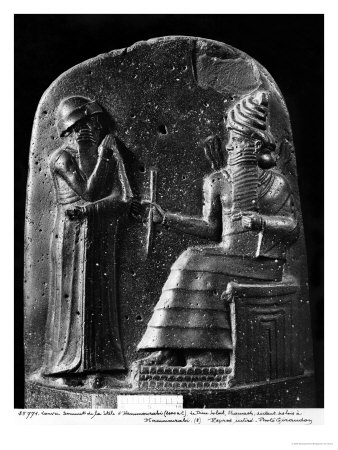 The Stele Law Code of Hammurabi, an ancient Babylonian artifact, is a slightly over seven-foot sculpture made from diorite and inscribed with the code of laws written by King Hammurabi of Babylon. This code of laws was written to cover just about any possible type of law for general society, particularly as dealing with criminal acts. This set of laws originally dictated by King Hammurabi had to be translated into several different languages around the empire, but the stele engraved with it is one of the greatest records we have of Babylonian law.
The Stele Law Code of Hammurabi, an ancient Babylonian artifact, is a slightly over seven-foot sculpture made from diorite and inscribed with the code of laws written by King Hammurabi of Babylon. This code of laws was written to cover just about any possible type of law for general society, particularly as dealing with criminal acts. This set of laws originally dictated by King Hammurabi had to be translated into several different languages around the empire, but the stele engraved with it is one of the greatest records we have of Babylonian law. Above the cuneiform script of the code of laws there exists a relief sculpture of King Hammurabi himself and a Babylonian god, Shamash, depicting the scene in which King Hammurabi received the code of law from Shamash. Generally, this scene is fairly well balanced, as the figures are similar in size, even though Shamash is presented sitting on something like a throne and King Hammurabi is standing. The god is larger in proportion to King Hammurabi however, as he is the more important of the two figures. On the left, King Hammurabi is still fairly large and before Shamash without an interpreter, thus showing what a close relationship to the god he himself has. It is interesting to note though, that despite the composite view of seeing different angles of the figures at once, both of their heads are carved in enough relief so as to be well presented in profile and facing each other equally. Again, such emphasis on the two figures exchange of near equality, gives King Hammurabi a great sense of power over most “mere mortals”.
Above the cuneiform script of the code of laws there exists a relief sculpture of King Hammurabi himself and a Babylonian god, Shamash, depicting the scene in which King Hammurabi received the code of law from Shamash. Generally, this scene is fairly well balanced, as the figures are similar in size, even though Shamash is presented sitting on something like a throne and King Hammurabi is standing. The god is larger in proportion to King Hammurabi however, as he is the more important of the two figures. On the left, King Hammurabi is still fairly large and before Shamash without an interpreter, thus showing what a close relationship to the god he himself has. It is interesting to note though, that despite the composite view of seeing different angles of the figures at once, both of their heads are carved in enough relief so as to be well presented in profile and facing each other equally. Again, such emphasis on the two figures exchange of near equality, gives King Hammurabi a great sense of power over most “mere mortals”.When looking again at the whole sculpture, it can be seen that the large portion of text lends a sense of heavy repetition, particularly as the cuneiform alphabet seems to unfamiliar eyes to be very uniform. As well, such a repetition gives the piece a very balanced look horizontally, but seems to make it somewhat top heavy, as the text does not reach quite to the floor and there is no counter to the relief at the top.
As for the physical properties of the statue, the diorite that it is carved from gives it a particularly smooth texture in places where the carvings and actual stone has been well polished, in contrast to much of the writing, which seems to lend another more rough texture to the piece. In addition, the fact that it is made of such a durable stone gives the piece a very heavy sense of weight and endurance or permanence. The stone seems like because it is so large and stable, it would present a very difficult challenge to move and must therefore when it was made it must have been placed in a prominent position where it would remain for a long time after.
Pictures:
> Photo 1
> Photo 2
Additional Info:
> www.allaboutarchaeology.org
> www.historians.org
No comments:
Post a Comment